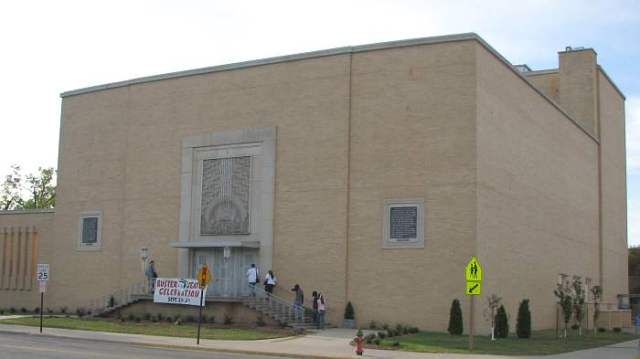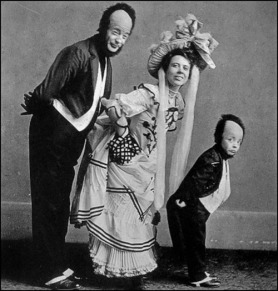
“Silence is of the gods; only monkeys chatter.” –Buster Keaton
There are three key silent clowns, each with a distinct style and legacy: Charlie Chaplin, Harold Lloyd, and Buster Keaton. Paired with amazing physical abilities and a great “stone face,” Keaton continues to be revered as an early silent film pioneer.
Buster Keaton was born in Piqua, Kansas, as his Vaudevillian parents passed through town. He was named “Joseph” to continue a tradition on his father’s side and “Frank” for his maternal grandfather. His father was Joseph Hallie “Joe” Keaton, who owned a traveling show with Harry Houdini called the Mohawk Indian Medicine Company, which performed on stage and sold patent medicine on the side. His mother was Myra Keaton.
Keaton acquired the nickname “Buster” at about 18 months of age. Keaton told interviewer Fletcher Markle that Houdini was present one day when the young Keaton took a tumble down a long flight of stairs without injury. After the infant sat up and shook off his experience, Houdini remarked, “That was a real buster!” According to Keaton, in those days, the word “buster” was used to refer to a spill or a fall that had the potential to produce injury. After this, it was Keaton’s father who began to use the nickname to refer to the youngster. Keaton retold the anecdote over the years, although its validity may just be Hollywood lore.
At the age of three, Keaton began performing with his parents in The Three Keatons. He first appeared on stage in 1899 in Wilmington, Delaware. The act was mainly a comedy sketch. Myra played the saxophone to one side, while Joe and Buster performed on center stage. The young Keaton would goad his father by disobeying him, and the elder Keaton would respond by throwing him against the scenery, into the orchestra pit, or even into the audience. A suitcase handle was sewn into Keaton’s clothing to aid with the constant tossing. The act evolved as Keaton learned to take trick falls safely; he was rarely injured or bruised on stage. This knockabout style of comedy led to accusations of child abuse, and occasionally, arrest. However, Buster Keaton was always able to show the authorities that he had no bruises or broken bones. He was eventually billed as “The Little Boy Who Can’t Be Damaged,” with the overall act being advertised as “‘The Roughest Act That Was Ever in the History of the Stage.” Decades later, Keaton said that he was never hurt by his father and that the falls and physical comedy were a matter of proper technical execution.
Keaton claimed he was having so much fun that he would sometimes begin laughing as his father threw him across the stage. Noticing that this drew fewer laughs from the audience, he adopted his famous deadpan expression whenever he was working.
Keaton served in the United States Army in France with the 40th Infantry Division during World War I. His unit remained intact and was not broken up to provide replacements, as happened to some other late-arriving divisions. During his time in uniform, he suffered an ear infection that permanently impaired his hearing.
In February 1917, Keaton met Roscoe “Fatty” Arbuckle at the Talmadge Studios in New York City. He was hired as a co-star and gag man, making his first appearance in The Butcher Boy. Keaton later claimed that he was soon Arbuckle’s second director and his entire gag department. He appeared in a total of 14 Arbuckle shorts, running into 1920. They were popular and, contrary to Keaton’s later reputation as “The Great Stone Face”, he often smiled and even laughed in them. Keaton and Arbuckle became close friends, and Keaton was one of few people to defend Arbuckle’s character during accusations that he was responsible for the death of actress Virginia Rappe.
In 1920, The Saphead was released, in which Keaton had his first starring role in a full-length feature. After Keaton’s successful work with Arbuckle, studio executive Joseph Schenck gave him his own production unit, Buster Keaton Comedies. He made a series of two-reel comedies, including One Week (1920), The Playhouse (1921), Cops (1922), and The Electric House (1922). Keaton then moved to full-length features.
Aside from Steamboat Bill Jr. (1928), Keaton’s most enduring feature-length films include Our Hospitality (1923), The Navigator (1924), Sherlock Jr. (1924), Seven Chances (1925), The Cameraman (1928), and The General (1926). Keaton would later work in films for Metro-Goldwyn-Mayer and make transitions into both sound and television. However, his most memorable works are his iconic silent roles.
Today, the rural town of Piqua, Kansas, holds a very small tribute to Buster Keaton in the form of a museum housed in the Rural Water District Office at 302 S. Hill. The museum is free and houses artifacts, pictures, and promotional materials related to Keaton.
The nearby town of Iola, Kansas, holds an Annual Buster Keaton Celebration. This year–2017–marks the centennial of Buster’s entrance into the film industry. Unfortunately, the celebration’s website holds that this may be their last year coordinating the festival.

Though Buster was born in Kansas, his family actually had strong ties to Muskegon, Michigan.
The Actors Colony was formed by Joe Keaton and friends in 1908. The community flourished until 1938. Here, performers could relax in a peaceful setting and enjoy nature before hitting the road again. In his biography, Keaton contended, “The best summers of my life were spent in the cottage Pop had built on Lake Muskegon in 1908.”
Buster’s family would vacation in their cottage, which was in close proximity to other cottages owned by fellow actors. Buster would return to his family’s cottage several times throughout his life.
The Keatons’ cottage stood at 1579 Edgewater, and Keaton Court is named after them. Buster’s father carved his name as well as his wife’s name into the wall of the cottage. The original structure was razed and rebuilt in the 1950s.
Visitors are encouraged to take a walking tour of the former Actors Colony, ideally during the well-attended Annual Buster Keaton “Damfinos” Convention. For more information, visit the Official Buster Keaton Society‘s website.
I became a Damfino in 2017 and was lucky enough to attend their convention in October of that year. To read more about the Annual Buster Keaton “Damfinos” Convention and other tributes or points of relevance to Buster’s time there, please visit my article about my trip.
This post was published as part of Silent-ology’s “Buster Keaton Blogathon.” To learn more about the blogathon, click here.


































Pingback: The Third Annual Buster Keaton Blogathon – Celebrating 100 Years of Buster! | Silent-ology
It is easy to place Keaton the filmmaker in context of his work, but I found your look at Keaton the boy in his environment exceptional reading.
Great piece on some of the places that are on my bucket list to visit one day! I always like seeing pictures of the little museum in Piqua. Even though it’s small, the fact that this little rural town hosts this unpretentious tribute to his life is very much up Buster’s alley. He was a down-to-earth kinda guy, after all.
Thank you for contributing this to the blogathon! 🙂
Hi Annette. That was a great way to approach Buster Keaton. I enjoyed the history and the views of Piqua and Muskegon. Thank you for sharing.
Buster as a boy…precious.
Pingback: Donald O’Connor | Hometowns to Hollywood
Love the article thanks do much for writing such a great piece on such a magical man.
Pingback: Hollywood Forever Cemetery | Hometowns to Hollywood
Pingback: Forest Lawn Memorial Park–Hollywood Hills | Hometowns to Hollywood
Pingback: Buster Keaton Convention 2017 | Hometowns to Hollywood
Pingback: The Hollywood Heritage Museum | Hometowns to Hollywood
Buster Keaton was one of my Dad’s favorite personalities when my Dad was a boy. My Dad was dropped off at Gilmore stadium in L.A. by my Grandfather where they were having a Halloween costume contest. My Dad won a bicycle tire and tube and it was presented to him by Buster Keaton.
What a cool story! Thanks for reading!
Pingback: Cliff Edwards | Hometowns to Hollywood
Pingback: My 2021 Top Ten | Hometowns to Hollywood
Pingback: Camera Man | Hometowns to Hollywood
Pingback: Buster Keaton: A Filmmaker’s Life | Hometowns to Hollywood